The Interface Interaction of C3N4/Bi2S3 Promoted the Separation of Excitons and the Extraction of Free Photogenerated Carriers in the Broadband Light Spectrum Range
Abstract
1. Introduction
2. Results and Discussion
3. Materials and Methods
3.1. Materials
3.2. Preparation of Graphitic Carbon Nitride
3.3. Preparation of the Bi2S3/C3N4 Nanocomposite
3.4. Characterization of SEM, TEM, UV–Vis–NIR, XRD, Raman, and PL
3.5. Photocurrent Measurements of the Bi2S3/C3N4 Nanocomposite in the Aggregation State with Light Sources of Different Wavelengths
4. Conclusions
Author Contributions
Funding
Institutional Review Board Statement
Informed Consent Statement
Data Availability Statement
Acknowledgments
Conflicts of Interest
References
- Amini, S.; Mohammadi, M.R.; Li, Y. Enhancing photovoltaic performance of dye-sensitized solar cells through TiO2/g-C3N4 nanocomposite photoanodes for improved charge carrier management. Electrochim. Acta 2025, 509, 145331. [Google Scholar] [CrossRef]
- Li, Q.; Wang, X.; Wang, W.; Wang, H.; Chen, Q.; Chen, J.; Chen, D. Constructing functionalized carbon quantum dots on amino-rich graphitic carbon nitride to enhance CO2 photocatalytic reduction: Critical role of functional group modulation. Sep. Purif. Technol. 2025, 355, 129780. [Google Scholar] [CrossRef]
- Guo, Z.; Li, Y.; You, Y.; Jiang, Z. Efficient UV–Vis–NIR Responsive CO2 Reduction Photocatalyst with Black Pinecone-Shaped Carbon Nitride Loaded with Lanthanum Oxide. ACS Appl. Mater. Interfaces 2024, 16, 63509–63519. [Google Scholar] [CrossRef]
- Zhou, F.; Li, W.; Wu, J.; Yang, W.; Sun, Y.; Zhou, H.; Jia, T.; Ling, Y.; He, P.; Pan, W.; et al. Enhanced solar-driven CO2 conversion: The role of Yb-doped CuInS2 quantum dots on g-C3N4 nanosheets. Appl. Catal. B Environ. Energy 2025, 362, 124716. [Google Scholar] [CrossRef]
- Yi, S.; Wang, Z.; Wu, Z.; Yang, X.; Wang, H.; Yang, J.; She, X.; Xu, H. Monodispersed Cu sites assembled on ultrathin 2D C3N4 for efficient electrocatalytic CO2 methanation. Appl. Surf. Sci. 2025, 681, 161492. [Google Scholar] [CrossRef]
- Zhang, B.; Liu, Y.; Wang, D.; He, W.; Fang, X.; Zhao, C.; Pan, J.; Liu, D.; Liu, S.; Chen, T.; et al. Nanoengineering construction of g-C3N4/Bi2WO6 S-scheme heterojunctions for cooperative enhanced photocatalytic CO2 reduction and pollutant degradation. Sep. Purif. Technol. 2025, 354, 128893. [Google Scholar] [CrossRef]
- He, Y.; Han, L.; Hou, Y.; Qiao, X.; Zhu, M. P3HT/g-C3N4 composite fiber membranes for high-performance photocatalytic hydrogen evolution. Appl. Surf. Sci. 2025, 682, 161673. [Google Scholar] [CrossRef]
- Yang, D.; Ye, Q.; Qu, C.; Meng, F.; Wang, L.; Li, Y. Visible-light-driven F/C co-doping g-C3N4 nanosheets for efficient hydrogen evolution: Charge redistribution on C4 delocalized large π bond. Appl. Catal. B Environ. Energy 2025, 361, 124637. [Google Scholar] [CrossRef]
- Ishak, N.; Galář, P.; Mekkat, R.; Grandcolas, M.; Šoóš, M. Fine-tuning photoluminescence and photocatalysis: Exploring the effects of carbon quantum dots synthesis and purification on g-C3N4. Colloids Surf. A Physicochem. Eng. Asp. 2025, 706, 135789. [Google Scholar] [CrossRef]
- Lin, Y.; Wang, H.; Zhou, Y.; Wu, Y. Construction of g-C3N4-based donor-acceptor conjugated copolymer for photocatalytic selective oxidation of biomass-derived 5-hydroxymethylfurfural under visible light. J. Mol. Struct. 2025, 1322, 140404. [Google Scholar] [CrossRef]
- Jayaprakash, K.; Sivasamy, A. Polymeric graphitic carbon nitride layers decorated with erbium oxide and enhanced photocatalytic performance under visible light irradiation. Environ. Sci. Pollut. Res. 2023, 30, 52561–52575. [Google Scholar] [CrossRef] [PubMed]
- Khan, M.A.; Mutahir, S.; Shaheen, I.; Qunhui, Y.; Bououdina, M.; Humayun, M. Recent advances over the doped g-C3N4 in photocatalysis: A review. Coord. Chem. Rev. 2025, 522, 216227. [Google Scholar] [CrossRef]
- Pei, J.; Li, H.; Zhuang, S.; Zhang, D.; Yu, D. Recent Advances in g-C3N4 Photocatalysts: A Review of Reaction Parameters, Structure Design and Exfoliation Methods. Catalysts 2023, 13, 1402. [Google Scholar] [CrossRef]
- Wang, Q.; Li, Y.; Huang, F.; Song, S.; Ai, G.; Xin, X.; Zhao, B.; Zheng, Y.; Zhang, Z. Recent Advances in g-C3N4-Based Materials and Their Application in Energy and Environmental Sustainability. Molecules 2023, 28, 432. [Google Scholar] [CrossRef] [PubMed]
- Li, Y.; Rao, F.; Zhong, J.; Li, J. In-situ fabrication of Bi2S3/g-C3N4 heterojunctions with boosted H2 production rate under visible light irradiation. Fuel 2023, 341, 127629. [Google Scholar] [CrossRef]
- Cao, J.S.; Chen, X.F.; Chen, C.; Chen, A.; Zheng, W. High efficiency Bi2S3/Bi2MoO6/TiO2 photoanode for photoelectrochemical hydrogen generation. J. Alloys Compd. 2023, 965, 171139. [Google Scholar] [CrossRef]
- Majumder, S.; Gu, M.; Kim, K.H. Facile fabrication of BiVO4/Bi2S3/NiCoO2 for significant photoelectrochemical water splitting. Appl. Surf. Sci. 2022, 574, 151562. [Google Scholar] [CrossRef]
- Wu, X.L.; Zhang, Q.T.; Su, C.L. Bi2MoO6/Bi2S3 S-scheme heterojunction for efficient photocatalytic oxygen evolution. Flatchem 2021, 27, 100244. [Google Scholar] [CrossRef]
- Chai, W.W.; Yang, F.; Yin, W.H.; You, S.Z.; Wang, K.; Ye, W.K.; Rui, Y.C.; Tang, B. Bi2S3/C nanorods as efficient anode materials for lithium-ion batteries. Dalton Trans. 2019, 48, 1906–1914. [Google Scholar] [CrossRef]
- Bai, J.; Chen, X.; Olsson, E.; Wu, H.M.; Wang, S.Q.; Cai, Q.; Feng, C.Q. Synthesis of Bi2S3/carbon nanocomposites as anode materials for lithium-ion batteries. J. Mater. Sci. Technol. 2020, 50, 92–102. [Google Scholar] [CrossRef]
- Zhan, L.; Ning, X.M.; Zhou, X.S.; Luo, J.; Fan, X.L. Flower-like Bi2S3/rGO modified separator for lithium-sulfur batteries. Adv. Powder Technol. 2022, 33, 103521. [Google Scholar] [CrossRef]
- Xiong, T.; Wang, Y.M.; Yin, B.S.; Shi, W.; Lee, W.S.V.; Xue, J.M. Bi2S3 for Aqueous Zn Ion Battery with Enhanced Cycle Stability. Nano-Micro Lett. 2020, 12, 8. [Google Scholar] [CrossRef] [PubMed]
- Nithya, C.; Modigunta, J.K.R.; In, I.; Kim, S.; Gopukumar, S. Bi2S3 Nanorods Deposited on Reduced Graphene Oxide for Potassium-Ion Batteries. Acs Appl. Nano Mater. 2023, 6, 6121–6132. [Google Scholar] [CrossRef]
- Guo, Y.; Zhang, X.X.; Zhang, R.; Li, A.Y.; Zhang, J.W.; He, H. Polyvinylpyrrolidone-modified Bi2O3 and Bi2S3 nanocomposites for improved supercapacitive performance. J. Mater. Sci.-Mater. Electron. 2023, 34, 670. [Google Scholar] [CrossRef]
- Ghosh, K.; Srivastava, S.K. Superior supercapacitor performance of Bi2S3 nanorod/reduced graphene oxide composites. Dalton Trans. 2020, 49, 16993–17004. [Google Scholar] [CrossRef]
- Agboola, P.O.; Shakir, I.; Almutairi, Z.A.; Shar, S.S.; Aboud, M.F.A. Ni-foam based heterogenous Bi2S3 polyhedrons/multi walled carbon nanotubes (Bi2S3@MWCNTs/NF) as an advanced battery type electrode for enhanced supercapacitor performance. J. Mater. Res. Technol. 2023, 23, 3177–3186. [Google Scholar] [CrossRef]
- Tian, Y.; Zhang, S.W.; Tan, W.S. Oxygen-doping to Bi2S3 thin film and its substrate-dependent resistive switching. Mater. Res. Express 2019, 6, 116324. [Google Scholar] [CrossRef]
- Zhao, X.; Zhi, M.; Hang, D.; Ren, Q.; Zhang, P.; Chen, C.; Chen, Q.; Li, Q.; Zhang, Z.; Yan, J.; et al. Ultrasensitive NO2 gas sensor based on MoS2 modified urchin-like Bi2S3 heterojunction. Phys. E-Low-Dimens. Syst. Nanostruct. 2023, 147, 115575. [Google Scholar] [CrossRef]
- Zhou, R.; Zhou, Q.X.; Li, X.D.; Ling, G.X.; Zhang, P. Applications of Bi2S3-based nanomaterials in photoelectric chemical sensors and biosensors. Flatchem 2022, 36, 100440. [Google Scholar] [CrossRef]
- Xi, J.J.; Wang, H.; Zhang, B.H.; Zhao, F.Q.; Zeng, B.Z. Novel molecularly imprinted photoelectrochemical sensor for rutin based on Bi2S3/ZnIn2S4 heterojunction. Sens. Actuators B Chem. 2020, 320, 128409. [Google Scholar] [CrossRef]
- Qu, C.L.; Li, H.; Zhou, S.; Li, G.D.; Wang, C.; Snyders, R.; Bittencourt, C.; Li, W.J. Bi2S3/rGO Composite Based Electrochemical Sensor for Ascorbic Acid Detection. Chemosensors 2021, 9, 190. [Google Scholar] [CrossRef]
- Kim, R.; Kim, J.; Do, J.Y.; Seo, M.W.; Kang, M. Carbon Dioxide Photoreduction on the Bi2S3/MoS2 Catalyst. Catalysts 2019, 9, 998. [Google Scholar] [CrossRef]
- Zhan, L.S.; Wang, Y.C.; Liu, M.J.; Zhao, X.; Wu, J.; Xiong, X.; Lei, Y.P. Hydropathy modulation on Bi2S3 for enhanced electrocatalytic CO2 reduction. Rare Met. 2023, 42, 806–812. [Google Scholar] [CrossRef]
- Liu, Y.F.; Chen, P.; Dai, G.Z.; Su, W.T.; Sun, Y.; Hou, J.S.; Zhang, N.; Zhao, G.Y.; Fang, Y.Z.; Dai, N. Single Bi2S3/Bi2S3-xOx nanowire photodetector with broadband response from ultraviolet to near-infrared range. Phys. E-Low-Dimens. Syst. Nanostruct. 2020, 120, 114041. [Google Scholar] [CrossRef]
- Chitara, B.; Kolli, B.S.C.; Yan, F. Near-Infrared photodetectors based on 2D Bi2S3. Chem. Phys. Lett. 2022, 804, 139876. [Google Scholar] [CrossRef]
- Sun, M.; Fan, K.; Liu, C.; Gui, T.; Dai, C.; Jia, Y.; Liu, X.; Zeng, C. Construction of an In2O3/Bi2S3 Z-Scheme Heterojunction for Enhanced Photocatalytic CO2 Reduction. Langmuir 2024, 40, 12681–12688. [Google Scholar] [CrossRef]
- Ning, X.M.; Huang, J.L.; Li, L.H.; Gu, Y.J.; Jia, S.G.; Qiu, R.F.; Kim, B.H. Branched Bi2S3/TiO2 nano-heterostructure with enhanced photoelectric performance. Mater. Res. Express 2019, 6, 125029. [Google Scholar] [CrossRef]
- Li, X.L.; Han, X.Y.; Zhu, D.; Chen, Y.C.; Li, L.H.; Ma, Z.H.; Gu, Y.J.; Ren, F.Z.; Huang, J.L. Improvement of photoelectric properties of TiO2/Bi2S3 composite film by annealing treatment. Opt. Mater. 2019, 91, 101–107. [Google Scholar] [CrossRef]
- Zhu, D.; Li, X.L.; Chen, Y.C.; Deng, Y.F.; Chen, D.; Wang, Y.W.; Ren, F.Z. Effect of Bi2S3 reaction concentration on the photoelectric properties of TiO2/Bi2S3 composite film. Mater. Res. Express 2019, 6, 095026. [Google Scholar] [CrossRef]
- Liaquat, H.; Imran, M.; Latif, S.; Iqbal, S.; Hussain, N.; Bilal, M. Citric acid-capped NiWO4/Bi2S3 and rGO-doped NiWO4/Bi2S3 nanoarchitectures for photocatalytic decontamination of emerging pollutants from the aqueous environment. Environ. Res. Part B 2022, 212, 113276. [Google Scholar] [CrossRef]
- Kim, J.H.; Lim, T.; Park, J.Y.; Ma, A.; Jung, H.; Kim, H.Y.; Cho, S.K.; Yoon, H.; Nam, K.M. Understanding and improving photoelectrochemical performance of Bi2O3/Bi2S3 composite. New J. Chem. 2019, 43, 11893–11902. [Google Scholar] [CrossRef]
- Fan, H.; Xu, M.; Ai, L.; Wang, L.; Guo, N.; Tan, C.; Wu, S. Photocatalyst for Antibiotics Degradation by In Situ Growth of Direct Z-Type Bi2S3/Bi4Ti3O12 Heterojunction. Inorg. Chem. 2024, 63, 22088–22100. [Google Scholar] [CrossRef]
- Li, N.; Zhu, B.; Huang, L.; Huo, L.; Dong, Q.; Ma, J. Piezoelectric Polarization and Sulfur Vacancy Enhanced Photocatalytic Hydrogen Evolution Performance of Bi2S3/ZnSn(OH)6 Piezo-photocatalyst. Inorg. Chem. 2024, 63, 10011–10021. [Google Scholar] [CrossRef]
- Shen, P.; Li, N.; Nasser, A.M.; Zhu, B.; Xi, X.; She, L.; Liu, Y.; Ma, J. Construction of a Bi2S3/Bi0.5Na0.5TiO3 Composite Catalyst with S Vacancies for Efficient Piezo-Photocatalytic Hydrogen Production. Langmuir 2024, 40, 20228–20239. [Google Scholar] [CrossRef] [PubMed]
- Pan, Y.; Dong, Z.; Qin, D.; Liu, B.; Cui, L.; Han, S.; Lin, H. Constructing Sequential Type II Heterojunction CQDs/Bi2S3/TiNbO Photoanode with Superior Charge Transfer Capability Toward Stable Photoelectrochemical Water Splitting. ACS Appl. Mater. Interfaces 2024, 16, 16062–16074. [Google Scholar] [CrossRef] [PubMed]
- Shao, P.; Ma, N.; Liu, J.; Dong, W.; Ge, Y.; Jia, L.; Song, H.; Zhao, H.; Lu, C.; Zhou, Y.; et al. Bi2S3 Nanoparticles on Bi2MoO6 Nanorods for Applications as Fast-Response Self-Powered Photoelectrochemical Photodetector and Water Splitting. ACS Appl. Nano Mater. 2024, 7, 20523–20535. [Google Scholar] [CrossRef]
- Luo, K.Y.; Zhao, J.L.; Jia, C.Z.; Chen, Y.K.; Zhang, Z.L.; Zhang, J.; Huang, M.X.; Wang, S.G. Integration of Fe3O4 with Bi2S3 for Multi-Modality Tumor Theranostics. Acs Appl. Mater. Interfaces 2020, 12, 22650–22660. [Google Scholar] [CrossRef]
- Zhuang, C.; Tang, L.Q.; Yu, Z.T.; Peng, T.X.; Zhang, Y.C.; Li, L.; Zhou, Y.; Zou, Z.G. Hollow BiVO4/Bi2S3 cruciate heterostructures with enhanced visible-light photoactivity. Catal. Sci. Technol. 2019, 9, 182–187. [Google Scholar] [CrossRef]
- Mahapatra, A.D.; Basak, D. Enhanced ultraviolet photosensing properties in Bi2S3 nanoparticles decorated ZnO nanorods’ heterostructure. J. Alloys Compd. 2019, 797, 766–774. [Google Scholar] [CrossRef]
- Ma, Y.; Lv, P.; Duan, F.; Sheng, J.L.; Lu, S.L.; Zhu, H.; Du, M.L.; Chen, M.Q. Direct Z-scheme Bi2S3/BiFeO3 heterojunction nanofibers with enhanced photocatalytic activity. J. Alloys Compd. 2020, 834, 155158. [Google Scholar] [CrossRef]
- Askari, N.; Beheshti, M.; Mowla, D.; Farhadian, M. Synthesis of CuWO4/Bi2S3 Z-scheme heterojunction with enhanced cephalexin photodegradation. J. Photochem. Photobiol. A-Chem. 2020, 394, 112463. [Google Scholar] [CrossRef]
- Ambre, S.K.; Patil, S.S.; Bhat, T.S.; Patil, P.S. Bi2S3-sensitized TiO2 nanorods by bottom-up approach for photoelectrochemical solar cell. J. Solid State Electrochem. 2023, 27, 337–343. [Google Scholar] [CrossRef]
- Zeng, L.W.; Zhao, H.; Zhu, Y.D.; Chen, S.P.; Zhang, Y.S.; Wei, D.; Sun, J.; Fan, H.S. A one-pot synthesis of multifunctional Bi2S3 nanoparticles and the construction of core-shell Bi2S3@Ce6-CeO2 nanocomposites for NIR-triggered phototherapy. J. Mater. Chem. B 2020, 8, 4093–4105. [Google Scholar] [CrossRef]
- Guo, H.X.; Zhang, Y.R.; Wang, S.; Li, L.L.; Wang, W.M.; Sun, Q.S. In-situ generation of Bi2S3 to construct WO3/BiVO4/Bi2S3 heterojunction for photocathodic protection of 304SS. J. Electroanal. Chem. 2022, 907, 116033. [Google Scholar] [CrossRef]
- Chowdhury, A.; Hudait, N.; Bera, K.K.; Mahapatra, A.; Bhattacharya, S.K. Unfolding Photocatalytic Efficiency of a Newly One-Pot Synthesized n-n-AgBi3S5-Bi2S3 Photocatalyst for Removal of Rhodamine-B from Aqueous Systems under Natural Light Illumination. ACS Sustain. Resour. Manag. 2024, 1, 2014–2031. [Google Scholar] [CrossRef]
- Lv, M.; Wang, H.; Jin, S.M.; Song, X.L.; Chang, X.H. Interfacial bond endowing FeS2/Bi2S3 composites superb OER performance. Mater. Chem. Phys. 2023, 298, 127398. [Google Scholar] [CrossRef]
- Paul, S.; Dalal, B.; Jana, R.; Shit, A.; Datta, A.; De, S.K. Enhanced Photophysical Properties of Bi2S3/AgBiS2 Nanoheterostructures Synthesized via Ag(I) Cation Exchange-Mediated Transformation of Binary Bi2S3. J. Phys. Chem. C 2020, 124, 12824–12833. [Google Scholar] [CrossRef]
- Xiao, Y.; Li, H.; Yao, B.; Wang, Y. Hollow core-shell B-g-C3N4-x@Bi2S3/In2S3 dual S-scheme heterojunction photothermal nanoreactor: Boosting photothermal catalytic activity in confined space. Chem. Eng. J. 2024, 484, 149399. [Google Scholar] [CrossRef]
- Zhang, H.; Zhang, M.; Yu, Z.; Zhou, Y.; Hu, Y.; Gao, L.; Cao, L.; Yin, H.; Ai, S. MXene-Enhanced Bi2S3/CdIn2S4 Heterojunction Photosensitive Gate for DEHP Detection in a Signal-On OPECT Aptamer Biosensor. Anal. Chem. 2024, 96, 1948–1956. [Google Scholar] [CrossRef]
- Kumar, M.S.; Madhusudanan, S.P.; Mohanta, K.; Batabyal, S.K. Development and characterization of photodiode from p-Cu2CdSnS4/n-Bi2S3 heterojunction. Mater. Res. Express 2020, 7, 015909. [Google Scholar] [CrossRef]
- Al-Zahrani, A.A.; Zainal, Z.; Talib, Z.A.; Lim, H.N.; Holi, A.M.; Bahrudin, N.N. Enhanced photoelectrochemical performance of Bi2S3/Ag2S/ZnO novel ternary heterostructure nanorods. Arab. J. Chem. 2020, 13, 9166–9178. [Google Scholar] [CrossRef]
- Shi, L.Y.; Ma, Z.L.; Qu, W.W.; Zhou, W.; Deng, Z.Q.; Zhang, H.F. Hierarchical Z-scheme Bi2S3/CdS heterojunction: Controllable morphology and excellent photocatalytic antibacterial. Appl. Surf. Sci. 2021, 568, 150923. [Google Scholar] [CrossRef]
- Sabarinathan, M.; Vijay, V.; Harish, S.; Hayakawa, Y. Enhanced thermoelectric performance of MoS2-Bi2S3 nanocomposites via low carrier effect. Surf. Interfaces 2023, 41, 103140. [Google Scholar] [CrossRef]
- Meng, S.P.; Ogawa, T.; Okumura, H.; Ishihara, K.N. Enhanced Photocatalytic Activity of BiVO4/Bi2S3/SnS2 Heterojunction under Visible Light. Catalysts 2020, 10, 1294. [Google Scholar] [CrossRef]
- Krishnamoorthy, D.; Singh, A.K. Investigating the Exfoliated Hexagonal Boron Nitride Nanosheets Embedded on Bi2S3 Nanorods Designed as a Positive Electrode for Hybrid Supercapacitors. Energy Fuels 2024, 38, 21468–21481. [Google Scholar] [CrossRef]
- Muniyandi, G.R.; Ubagaram, J.; Srinivasan, A.; James, D.R.; Pugazhenthiran, N.; Govindasamy, C.; Joseph, J.A.; Bosco, A.J.; Mahalingam, S.; Kim, J. Advanced Z-scheme H-g-C3N4/Bi2S3 nanocomposites: Boosting photocatalytic degradation of antibiotics under visible light exposure. J. Ind. Eng. Chem. 2024, 140, 647–657. [Google Scholar] [CrossRef]
- Liu, X.; Cheng, Z.; Lin, L.; Xu, W.; Chen, S.; Zhuang, H. Fabrication of ternary Bi2S3/BiVO4/g-C3N4 composite material for enhanced photocatalytic degradation of antibiotics. Diam. Relat. Mater. 2024, 148, 111376. [Google Scholar] [CrossRef]
- Yang, K.; Yang, Y.; Jiang, Y.; Ye, B.; Li, L.; Liu, W.; Yan, T.; Li, W.; Liu, S. Controlled synthesis of Bi2S3/g-C3N4 nanosheets for efficient degradation of rhodamine B and reduction of Cr (VI) under visible light. Surf. Interfaces 2024, 52, 104885. [Google Scholar] [CrossRef]
- Sun, Y.; Ren, C.; Lei, J.; Zhang, Z.; Piao, M.; Tang, Q.; Teng, H. Efficient organic contaminant degradation by visible-light-driven Z-scheme g-C3N4/Bi2S3 heterojunction under the experimental and natural environment. J. Mol. Struct. 2024, 1318 Pt 2, 139247. [Google Scholar] [CrossRef]
- Xing, Z.; Liang, H.; Zhang, C.; Li, Y.; Bai, J. Facile synthesis of Al-g-C3N4/Bi2S3 with enhanced for CO2 cycloaddition reaction performance. Mater. Lett. 2024, 367, 136617. [Google Scholar] [CrossRef]
- Rajendran, R.; Rojviroon, O.; Arumugam, P.; Natchimuthu, K.; Vasudevan, V.; Kannupaiyan, J.; Muangmora, R.; Phouheuanghong, P.; Rojviroon, T. Design and fabrication of g-C3N4/Bi2S3 heterojunction photocatalysts for efficient organic pollutant degradation and antibacterial activity. J. Alloys Compd. 2024, 976, 173116. [Google Scholar] [CrossRef]
- Meng, Y.C.; Li, Y.Z.; Xia, Y.S.; Chen, W.J. Z-scheme heterojunction of Bi2S3/g-C3N4 and its photocatalytic effect. Indian J. Chem. Technol. 2022, 29, 128–138. [Google Scholar]
- Bai, Y.; Ouyang, T.; Li, X.; Yan, Y.; Kong, Z.; Ma, X.; Li, Z.; Li, Z.; Cai, X.; Cai, J.; et al. Boosting the thermoelectric performance of n-type Bi2S3 by compositing rGO. J. Alloys Compd. 2023, 933, 167814. [Google Scholar] [CrossRef]
- Liu, G.S.; Dai, S.X.; Cao, F.L.; Zhu, B.H.; Li, P.; Gu, Y.Z. Preparation and enhanced nonlinear optical properties of Bi2S3/RGO composite materials. Opt. Mater. 2019, 89, 112–117. [Google Scholar] [CrossRef]
- Nwaji, N.; Akinoglu, E.M.; Giersig, M. Gold Nanoparticle-Decorated Bi2S3 Nanorods and Nanoflowers for Photocatalytic Wastewater Treatment. Catalysts 2021, 11, 355. [Google Scholar] [CrossRef]
- Zhao, X.S.; Li, S.W.; Huang, T.D.; Sun, H.M.; Zhu, H.D.; Guo, H.L.; Liu, M.X. Synthesis of Au/Bi2S3 nanoflowers for efficient photothermal therapy. New J. Chem. 2020, 44, 18724–18731. [Google Scholar] [CrossRef]
- Arumugam, J.; George, A.; Raj, A.D.; Irudayaraj, A.A.; Josephine, R.L.; Sundaram, S.J.; Algarni, T.S.; Al-Mohaimeed, A.M.; Balasubramanian, B.; Kaviyarasu, K. Improved Ag doped Bi2S3 nanowire-based photodiode: Fabrication and performance. Mater. Lett. 2021, 302, 130403. [Google Scholar] [CrossRef]
- Cao, J.Y.; He, J.H.; Ye, J.; Ge, K.; Zhang, Y.; Yang, Y.F. Urchin-Like Bi2S3/Ag Nanostructures for Photocatalytic Reduction of Cr(VI). ACS Appl. Nano Mater. 2021, 4, 1260–1269. [Google Scholar] [CrossRef]
- Wang, B.; Liu, Y.; Huai, X.; Miao, Y.Q. Ni-doped, urchin-like Bi2S3 particles for electrocatalytic oxidation of glucose. Funct. Mater. Lett. 2021, 14, 2150006. [Google Scholar] [CrossRef]
- Liang, S.Y.; Teng, F.; Hao, W.Y.; Gu, W.H.; Sun, P.P.; Zhai, S.Y.; Yang, X.M. Fabrication of flexible, foldable Ag/Bi2S3 nanoflowers-based asymmetric micro-capacitor. Micro Nano Lett. 2020, 15, 614–617. [Google Scholar] [CrossRef]
- Jia, H.; Wang, Z.W.; Cai, R.; Wang, Z.L.; Yuan, Y.H.; Yue, T.L. Fabrication of hierarchical 3D Ag/Bi2S3 nanoflowers for antibacterial application. J. Alloys Compd. 2022, 912, 165225. [Google Scholar] [CrossRef]
- Shao, X.L.; Liu, Y.Y. Preparation of Bi-Bi2S3 Catalyst to Promote Electron Transfer for CO2. J. Electrochem. Soc. 2022, 169, 026505. [Google Scholar] [CrossRef]
- Ji, W.T.; Yu, H.D.; Zhou, D.Y.; Li, X.J.; Fan, X.; Zhang, Y.W.; Ma, H.A.; Jia, X.P. Cation and anion doping to enhance thermoelectric performance of Bi2S3. J. Solid State Chem. 2023, 322, 123990. [Google Scholar] [CrossRef]
- Kim, Y.; Jeong, E.; Lee, C. High-Performance Phototransistor Based on Ultrathin Two-Dimensional Single-Crystalline Bi2S3. ACS Appl. Electron. Mater. 2024, 6, 7883–7889. [Google Scholar] [CrossRef]
- Kilcoyne, C.; Ali, A.H.; Alsaqqa, A.M.; Rahman, A.A.; Whittaker-Brooks, L.; Sambandamurthy, G. Gate-tunable transport characteristics of Bi2S3 nanowire transistors. Solid State Commun. 2018, 270, 135–139. [Google Scholar] [CrossRef]
- Andzane, J.; Kunakova, G.; Varghese, J.; Holmes, J.D.; Erts, D. Photoconductive properties of Bi2S3 nanowires. J. Appl. Phys. 2015, 117, 064305. [Google Scholar] [CrossRef]
- Xi, Y.; Hu, C.; Zhang, X.; Zhang, Y.; Wang, Z.L. Optical switches based on Bi2S3 nanowires synthesized by molten salt solvent method. Solid State Commun. 2009, 149, 1894–1896. [Google Scholar] [CrossRef]
- Bao, H.; Cui, X.; Li, C.M.; Gan, Y.; Zhang, J.; Guo, J. Photoswitchable Semiconductor Bismuth Sulfide (Bi2S3) Nanowires and Their Self-Supported Nanowire Arrays. J. Phys. Chem. C 2007, 111, 12279–12283. [Google Scholar] [CrossRef]
- Kunakova, G.; Viter, R.; Abay, S.; Biswas, S.; Holmes, J.D.; Bauch, T.; Lombardi, F.; Erts, D. Space charge limited current mechanism in Bi2S3 nanowires. J. Appl. Phys. 2016, 119, 114308. [Google Scholar] [CrossRef]
- Chen, J.L.T.; Nalla, V.; Kannaiyan, G.; Mamidala, V.; Ji, W.; Vittal, J.J. Synthesis and nonlinear optical switching of Bi2S3 nanorods and enhancement in the NLO response of Bi2S3@Au nanorod-composites. New J. Chem. 2014, 38, 985–992. [Google Scholar] [CrossRef]
- Ma, X.; Li, C.; Zhang, X.; Gao, M.; Wang, Y.; Li, G. Interface Optimisation of the Fe2O3/C3N4 Heterojunction with Metal Nanoparticles and Their Negative and Positive Photoelectric Responses in a Broadband Light Spectrum Range. Coatings 2024, 14, 1595. [Google Scholar] [CrossRef]
- Pérez-Torres, A.F.; Hernández-Barreto, D.F.; Bernal, V.; Giraldo, L.; Moreno-Piraján, J.C.; da Silva, E.A.; Alves, M.D.C.M.; Morais, J.; Hernandez, Y.; Cortés, M.T.; et al. Sulfur-Doped g-C3N4 Heterojunctions for Efficient Visible Light Degradation of Methylene Blue. ACS Omega 2023, 8, 47821–47834. [Google Scholar] [CrossRef] [PubMed]
- Wang, S.; Lv, Y.; Trigub, M.V.; Yang, X. Paper-based AuNPs/Bi2S3/PbS broadband photodetector with PDMS package. J. Alloys Compd. 2025, 1010, 177627. [Google Scholar] [CrossRef]
- Yu, X.; Cao, C. Photoresponse and Field-Emission Properties of Bismuth Sulfide Nanoflowers. Cryst. Growth Des. 2008, 8, 3951–3955. [Google Scholar] [CrossRef]
- Chabib, L.; Nursal; Miskam, M.; Kaus, N.H.M.; Shafie, M.H.; Hamid, M.; Saragi, I.R.; Isnaeni, I.; Amilia, D.; Dalimunthe, I.B.; et al. Optimization of g-C3N4 nanoparticles on structural, morphological, and optical properties as organic pollutants adsorbent in glycerin. Case Stud. Chem. Environ. Eng. 2025, 11, 101057. [Google Scholar] [CrossRef]
- Zhang, X.; Xie, X.; Wang, H.; Zhang, J.; Pan, B.; Xie, Y. Enhanced Photoresponsive Ultrathin Graphitic-Phase C3N4 Nanosheets for Bioimaging. J. Am. Chem. Soc. 2013, 135, 18–21. [Google Scholar] [CrossRef]
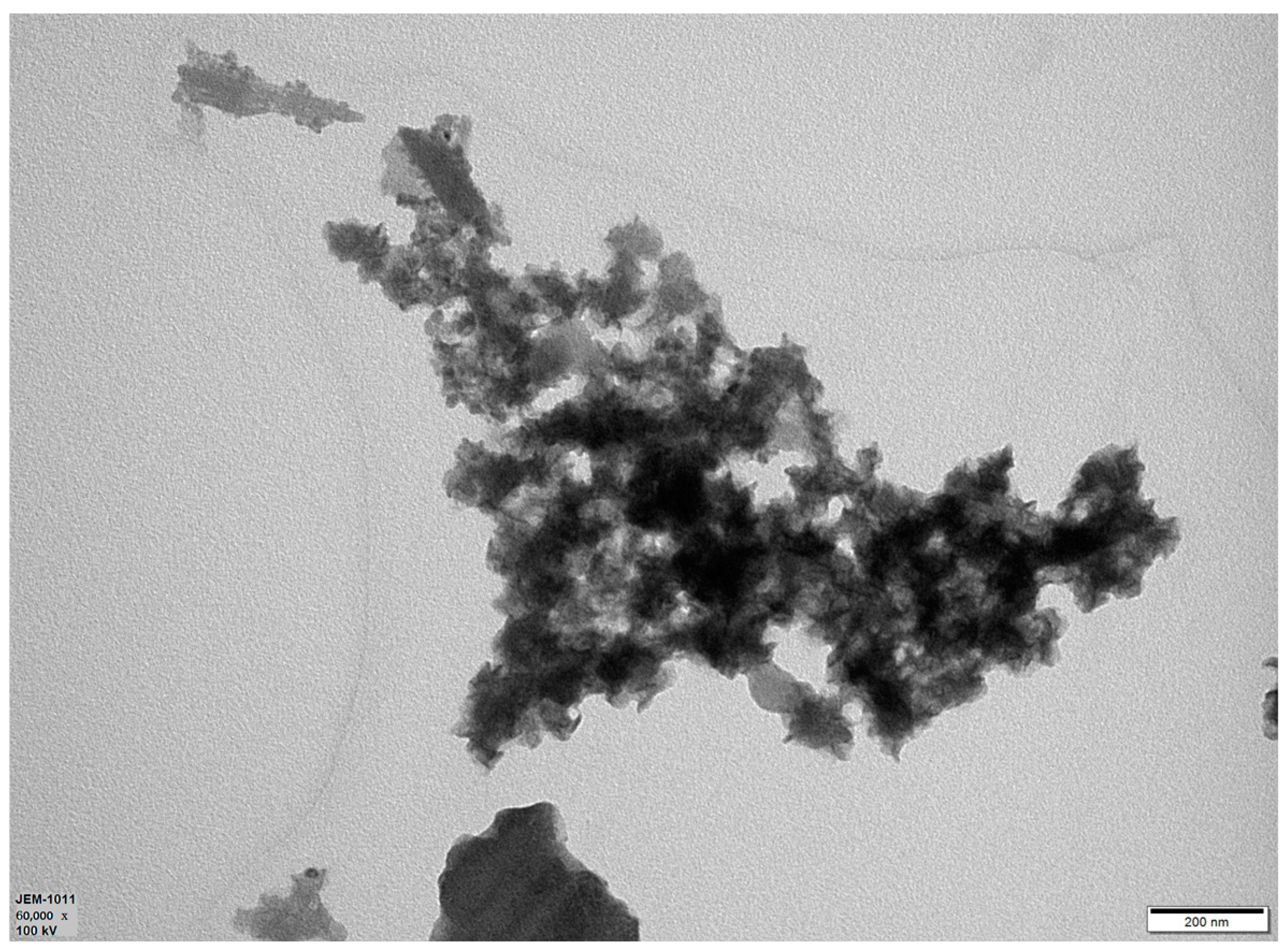
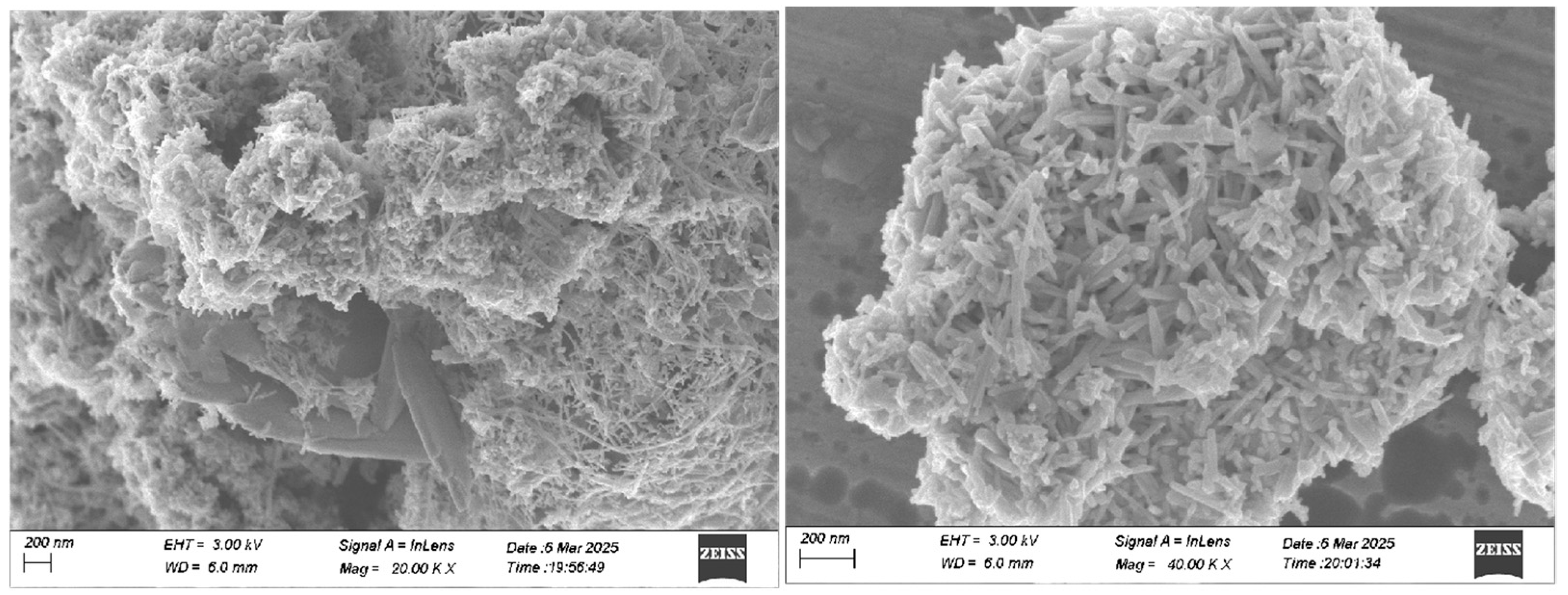

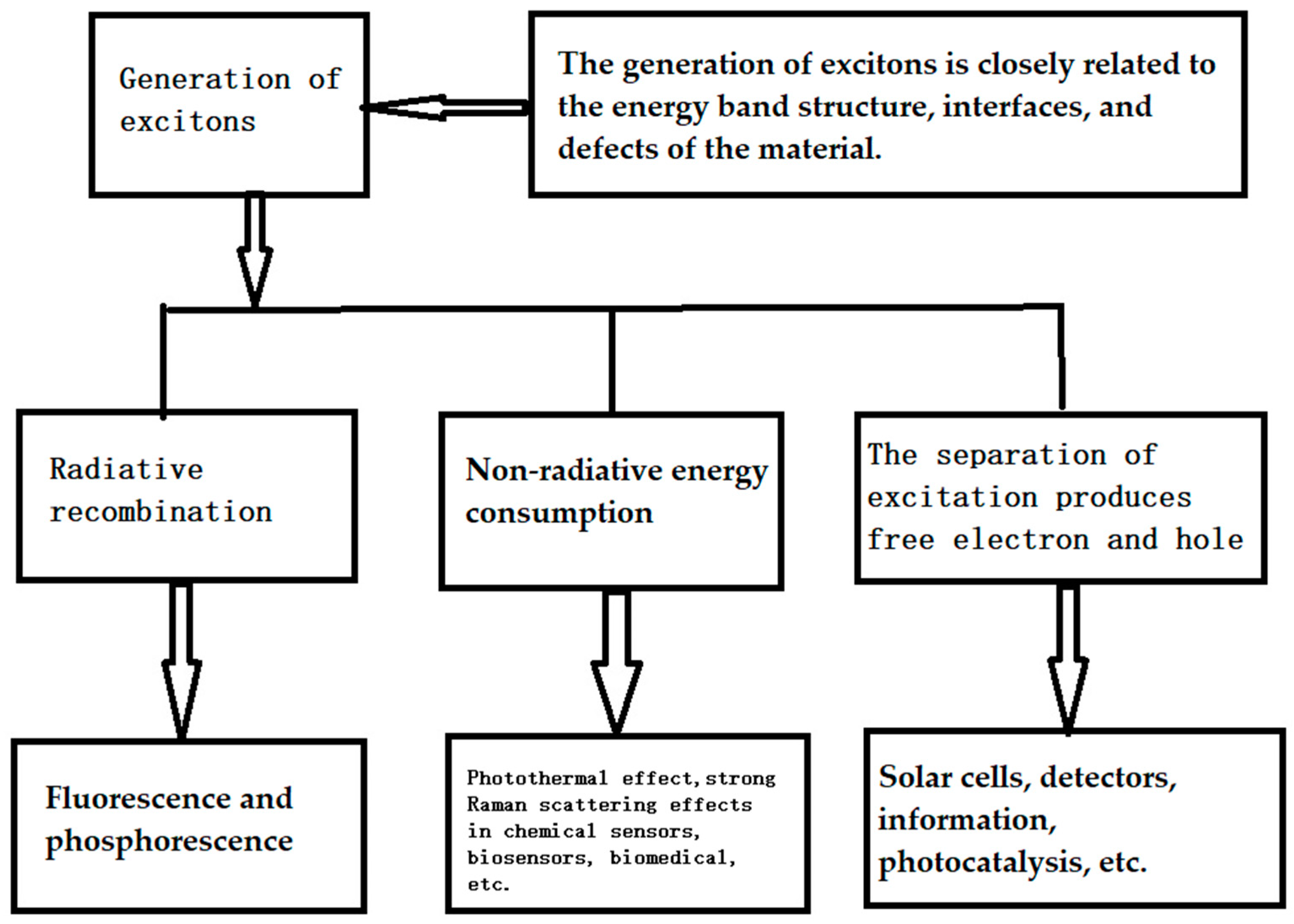
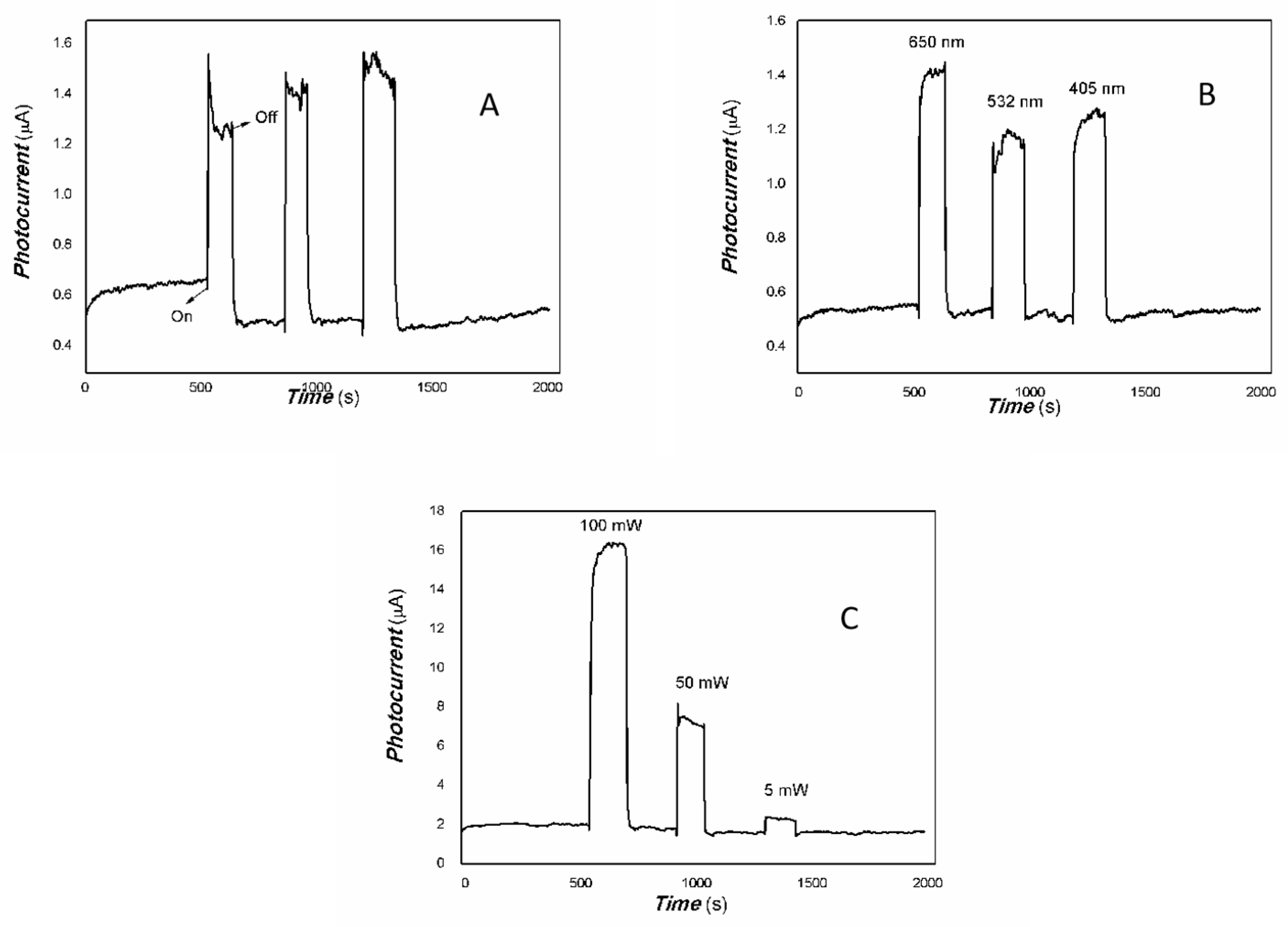
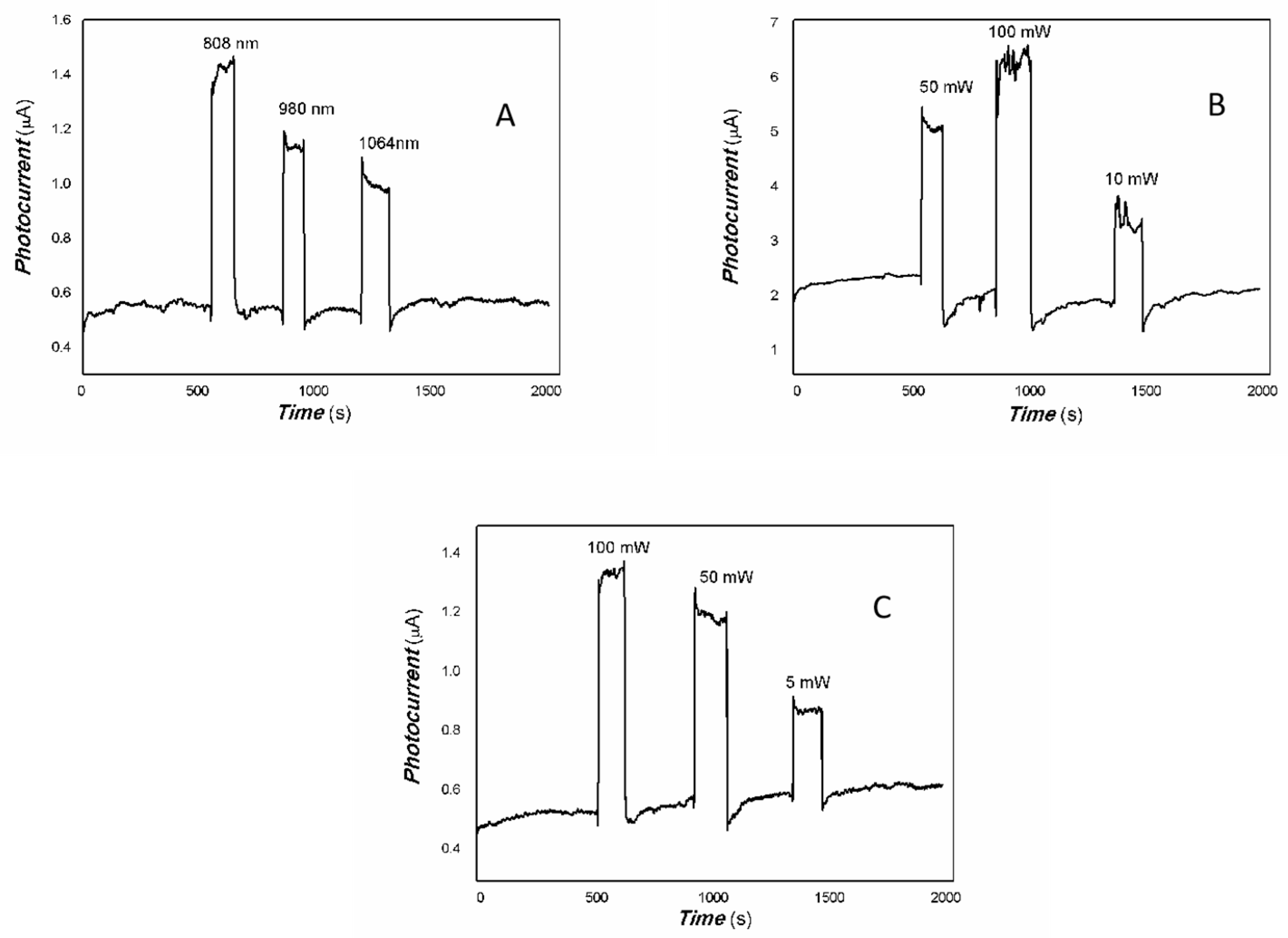
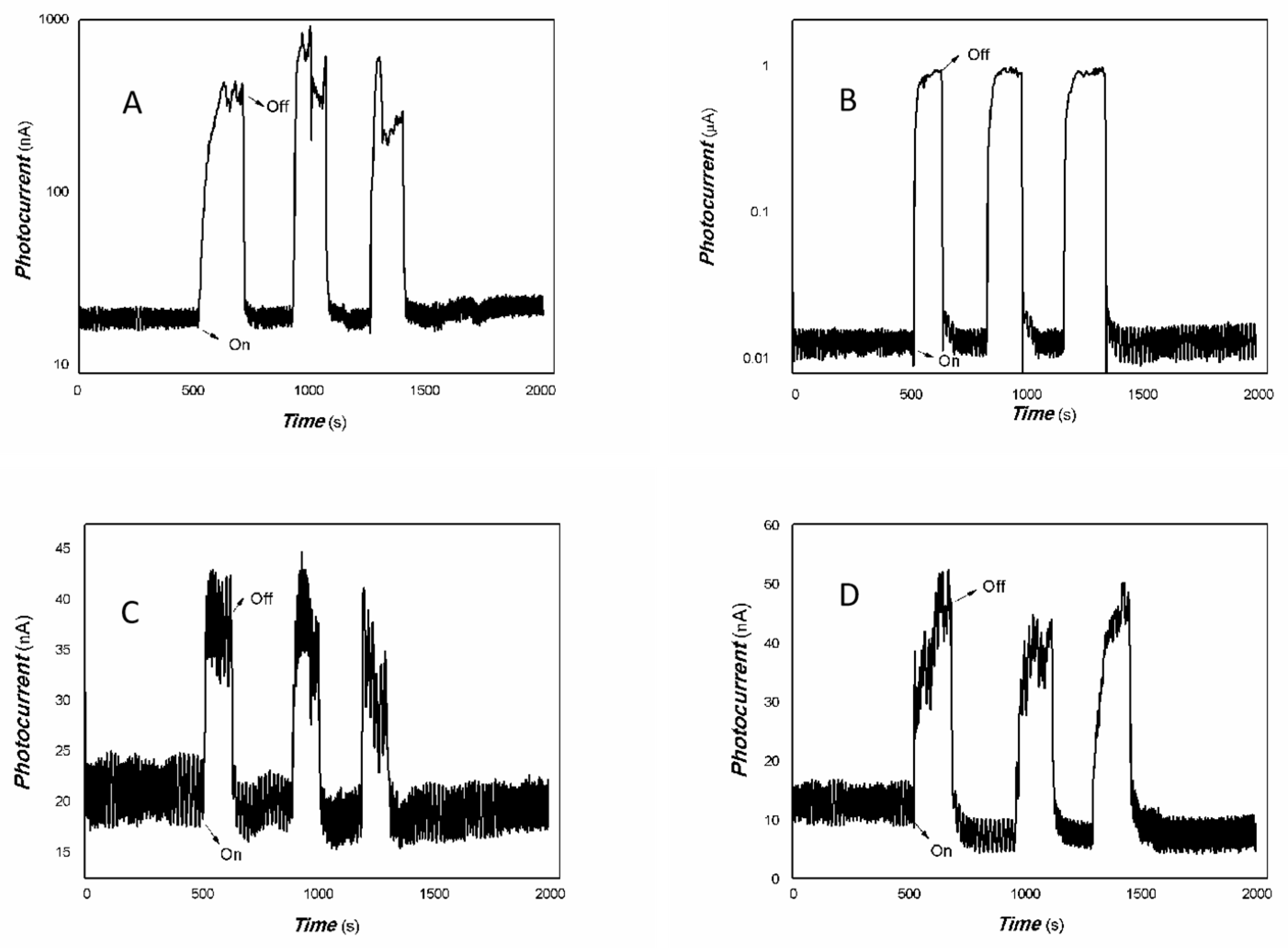

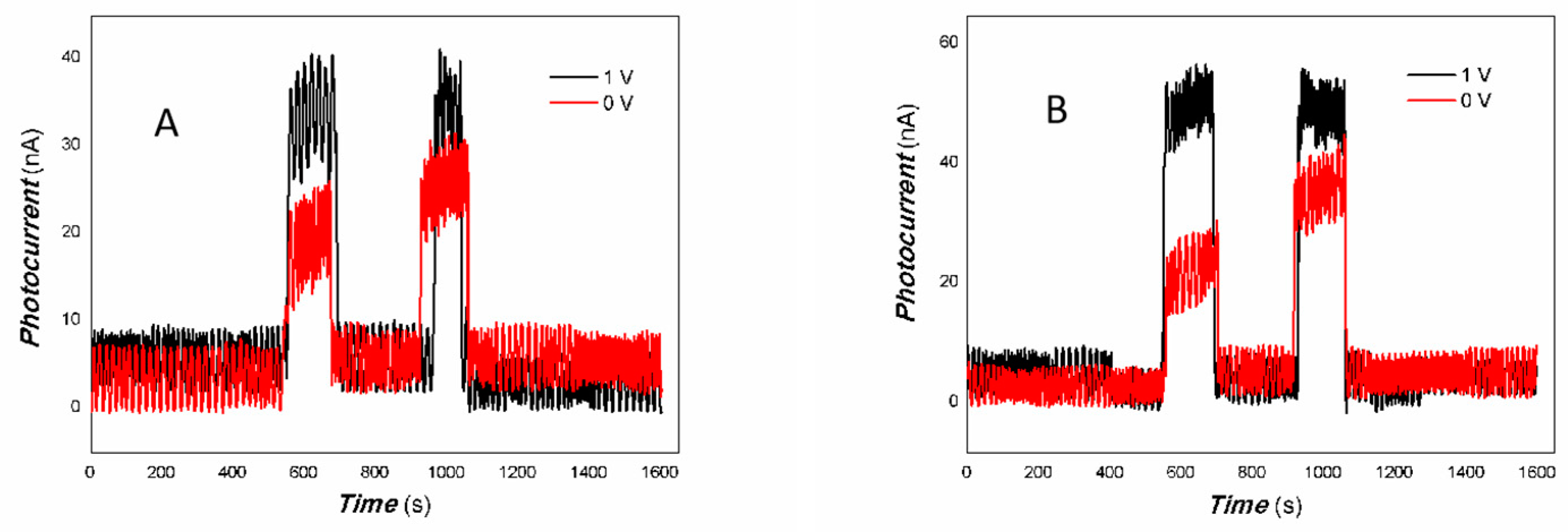
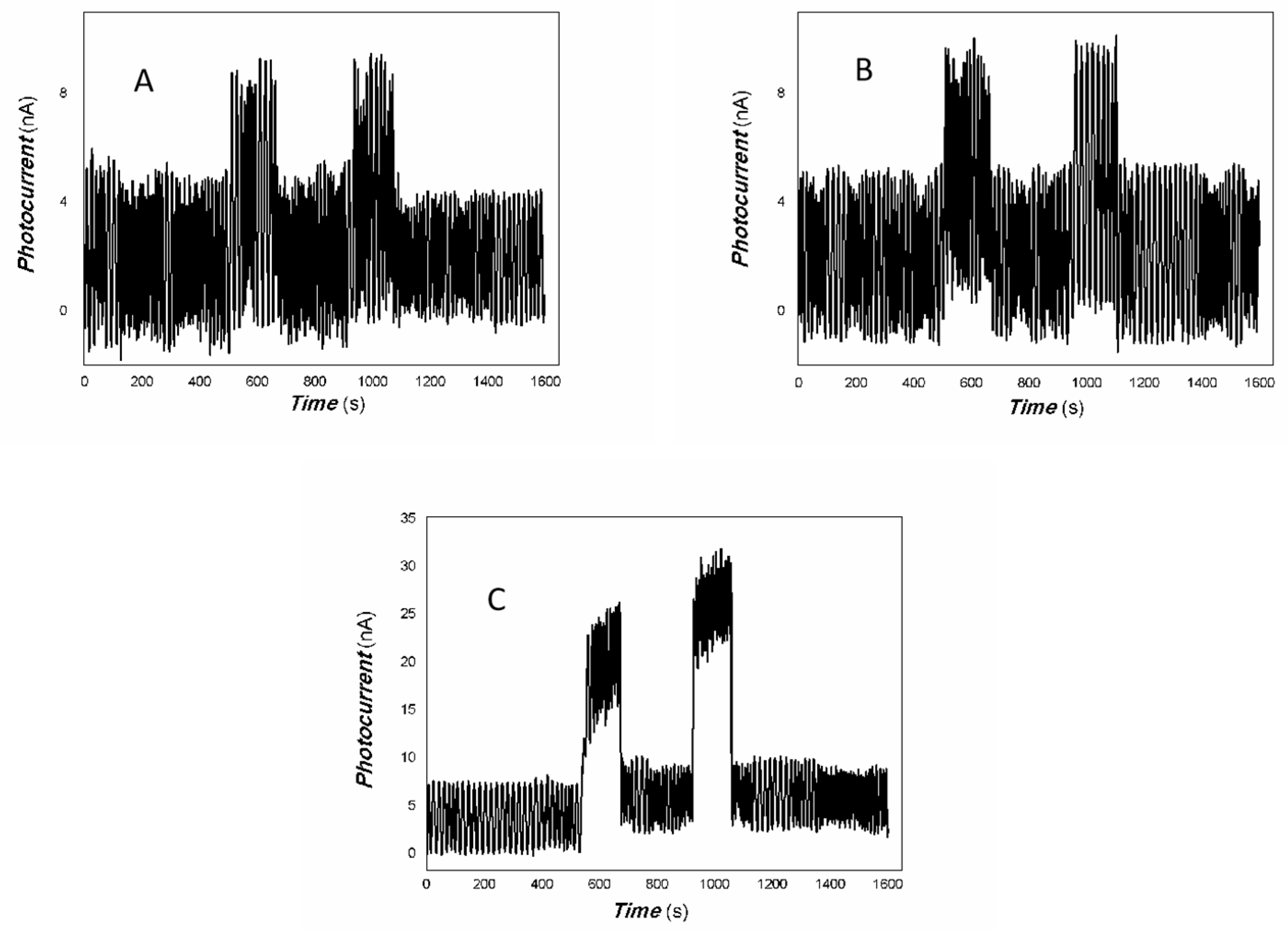
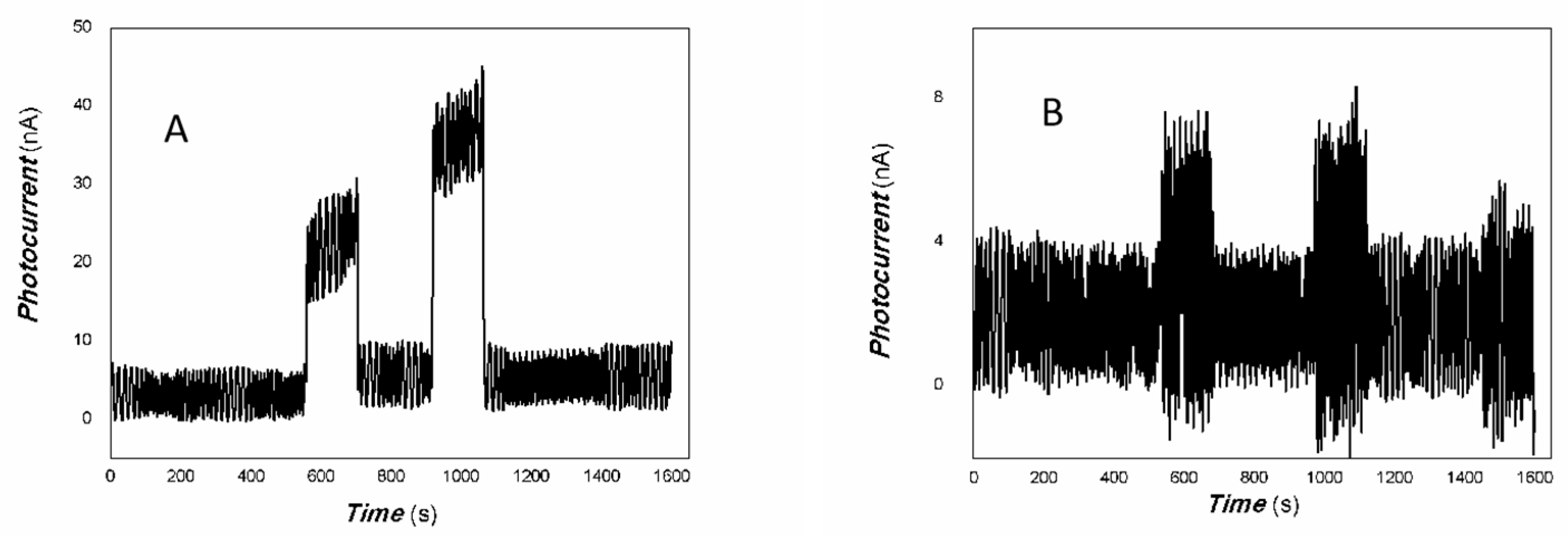
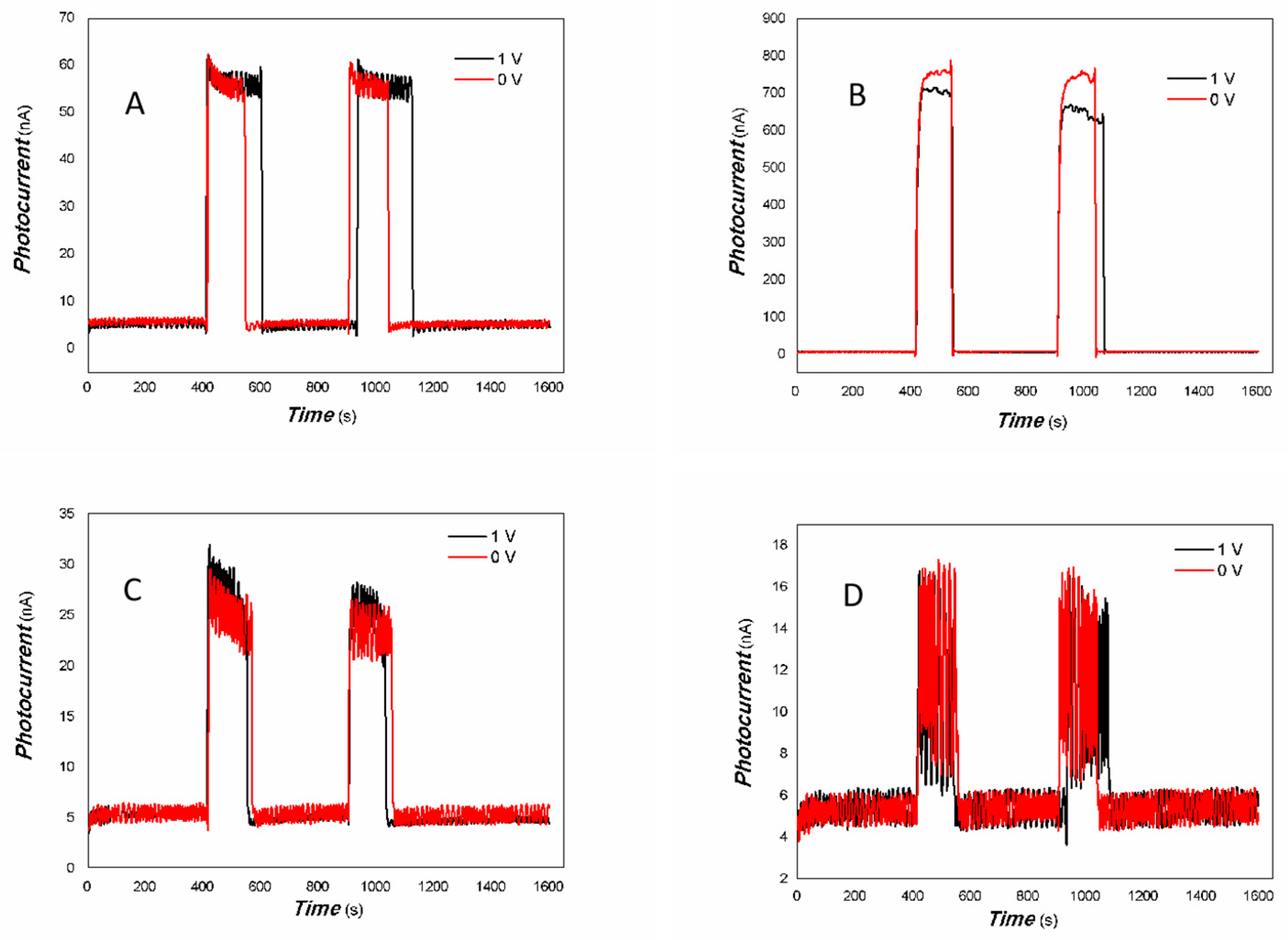
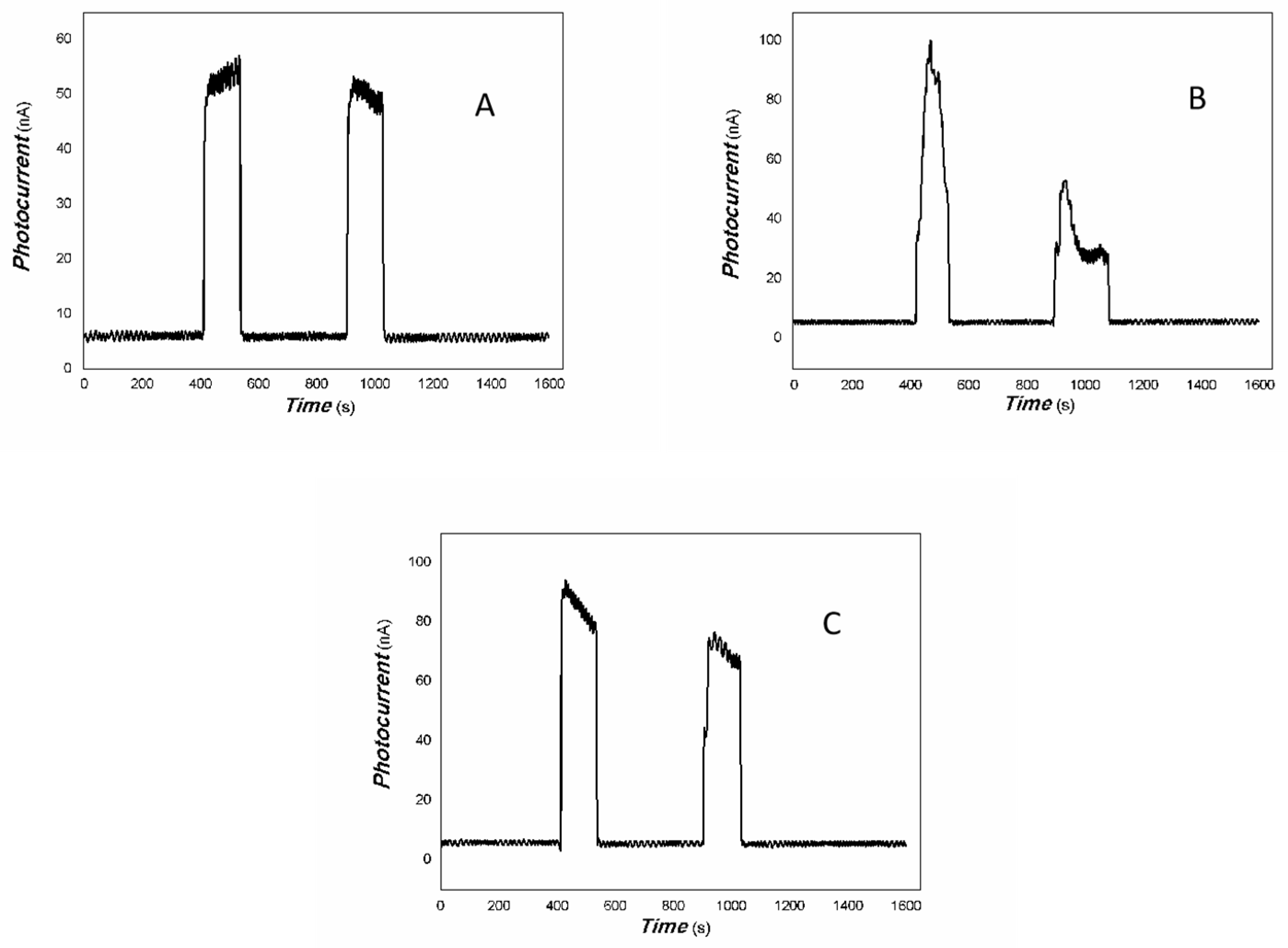






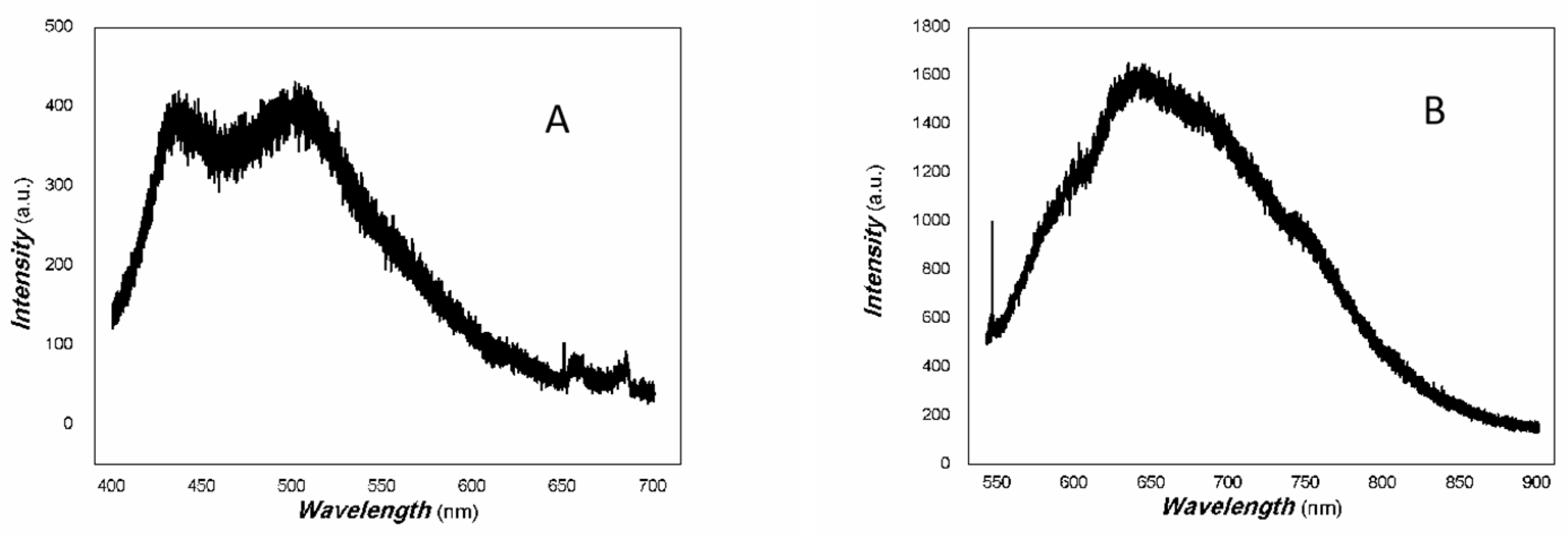
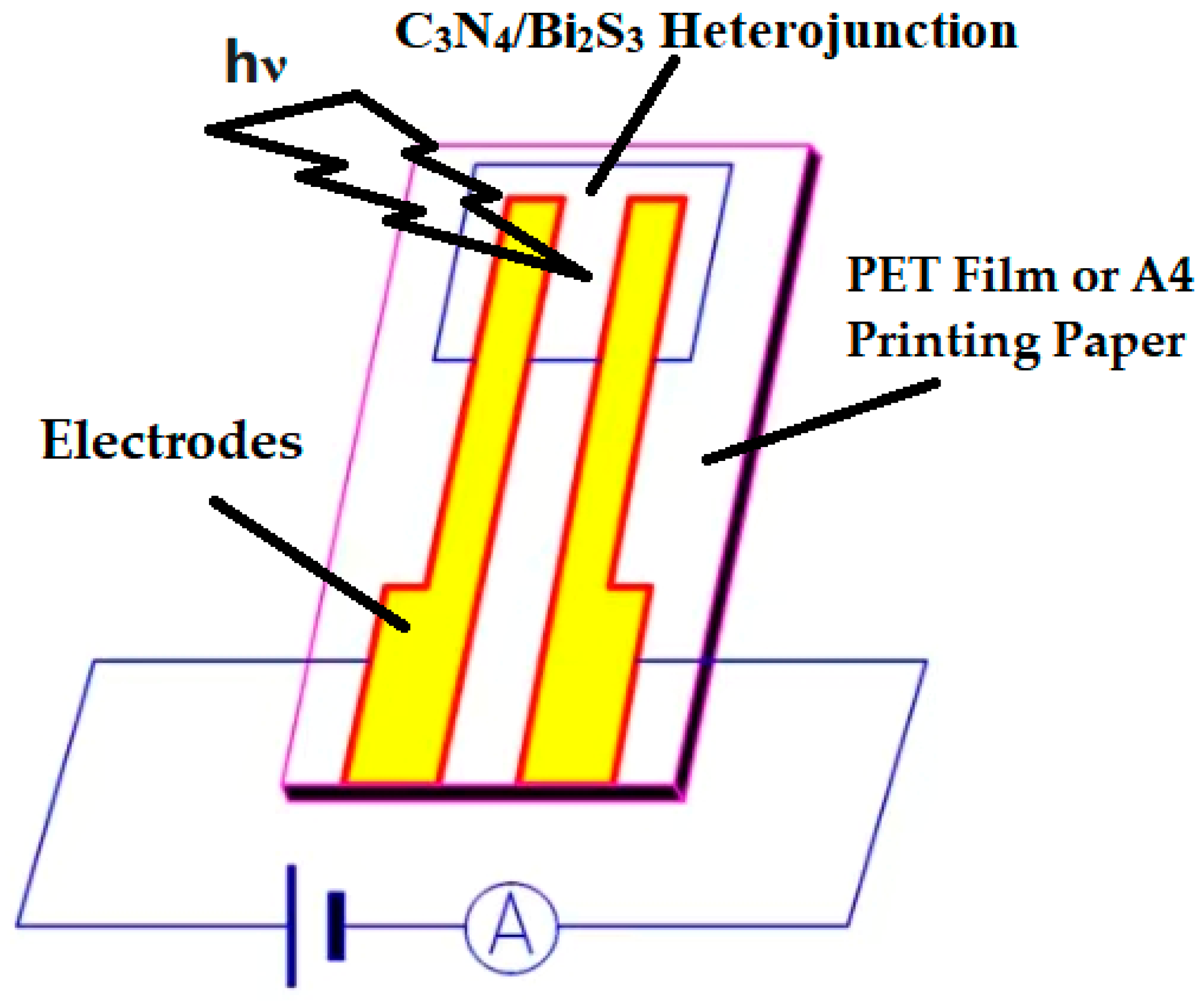
| Excitation Light Wavelength (nm) | Response Time (s) | Recovery Time (s) | Ratio of On/Off |
|---|---|---|---|
| 50 mW, 405 nm | 12.0 | 12.9 | 2.367 |
| 50 mW, 532 nm | 3.4 | 8.6 | 2.154 |
| 50 mW, 650 nm | 7.9 | 12.0 | 2.618 |
| 5 mW, 650 nm | 12 | 3.4 | 1.982 |
| 50 mW, 808 nm | 12.0 | 7.7 | 2.570 |
| 10 mW, 808 nm | 8.6 | 4.3 | 1.759 |
| 50 mW, 980 nm | 8.5 | 4.3 | 2.049 |
| 5 mW, 980 nm | 3.4 | 8.5 | 1.482 |
| 40 mW, 1064 nm | 4.3 | 4.3 | 1.785 |
| Excitation Light Wavelength (nm) | Response Time (s) | Recovery Time (s) | Ratio of On/Off |
|---|---|---|---|
| 50 mW, 405 nm | 16.3 | 7.7 | 1.681 |
| 50 mW, 532 nm | 16.3 | 4.3 | 9.333 |
| 50 mW, 650 nm | 20.6 | 12.0 | 2.533 |
| 50 mW, 780 nm | 8.6 | 12.0 | 1.176 |
| 50 mW, 808 nm | 16.3 | 7.7 | 4.942 |
| 10 mW, 808 nm | 5.2 | 25.1 | 1.173 |
| 100 mW, 980 nm | 16.3 | 12.0 | 1.739 |
| 50 mW, 980 nm | 4.3 | 8.6 | 1.247 |
| 40 mW, 1064 nm | 29.9 | 17.4 | 1.063 |
| Excitation Light Wavelength (nm) | Response Time (s) | Recovery Time (s) | Ratio of On/Off |
|---|---|---|---|
| 50 mW, 405 nm | 13.1 | 6.6 | 8.60 |
| 50 mW, 532 nm | 67.1 | 6.5 | 5.15 |
| 50 mW, 650 nm | 6.6 | 3.4 | 13.56 |
| 50 mW, 780 nm | 1.3 | 5.0 | 9.41 |
| 200 mW, 808 nm | 19.3 | 4.8 | 181.31 |
| 100 mW, 980 nm | 3.4 | 6.6 | 4.53 |
| 20 mW, 1064 nm | 10.0 | 16.6 | 3.09 |
| Excitation Light Wavelength (nm) | Response Time (s) | Recovery Time (s) | Ratio of On/Off |
|---|---|---|---|
| 5 mW, 650 nm | 7.9 | 8.4 | 1.55 |
| 5 mW, 780 nm | 15.9 | 11.7 | 3.51 |
| 5 mW, 808 nm | 4.2 | 8.0 | 5.69 |
| 5 mW, 980 nm | 4.2 | 7.9 | 2.90 |
Disclaimer/Publisher’s Note: The statements, opinions and data contained in all publications are solely those of the individual author(s) and contributor(s) and not of MDPI and/or the editor(s). MDPI and/or the editor(s) disclaim responsibility for any injury to people or property resulting from any ideas, methods, instructions or products referred to in the content. |
© 2025 by the authors. Licensee MDPI, Basel, Switzerland. This article is an open access article distributed under the terms and conditions of the Creative Commons Attribution (CC BY) license (https://creativecommons.org/licenses/by/4.0/).
Share and Cite
Ma, X.; Zhang, X.; Gao, M.; Hu, R.; Wang, Y.; Li, G. The Interface Interaction of C3N4/Bi2S3 Promoted the Separation of Excitons and the Extraction of Free Photogenerated Carriers in the Broadband Light Spectrum Range. Inorganics 2025, 13, 122. https://doi.org/10.3390/inorganics13040122
Ma X, Zhang X, Gao M, Hu R, Wang Y, Li G. The Interface Interaction of C3N4/Bi2S3 Promoted the Separation of Excitons and the Extraction of Free Photogenerated Carriers in the Broadband Light Spectrum Range. Inorganics. 2025; 13(4):122. https://doi.org/10.3390/inorganics13040122
Chicago/Turabian StyleMa, Xingfa, Xintao Zhang, Mingjun Gao, Ruifen Hu, You Wang, and Guang Li. 2025. "The Interface Interaction of C3N4/Bi2S3 Promoted the Separation of Excitons and the Extraction of Free Photogenerated Carriers in the Broadband Light Spectrum Range" Inorganics 13, no. 4: 122. https://doi.org/10.3390/inorganics13040122
APA StyleMa, X., Zhang, X., Gao, M., Hu, R., Wang, Y., & Li, G. (2025). The Interface Interaction of C3N4/Bi2S3 Promoted the Separation of Excitons and the Extraction of Free Photogenerated Carriers in the Broadband Light Spectrum Range. Inorganics, 13(4), 122. https://doi.org/10.3390/inorganics13040122



_Ma.jpg)



